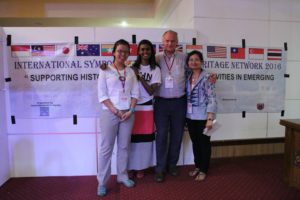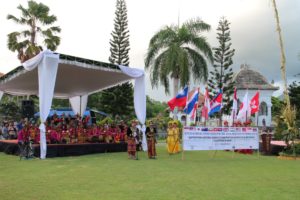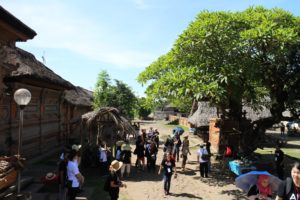-
ASIA HERITAGE NETWORK, A MELTING POT FOR ASIAN HERITAGE ACTIVISTS
Posted on April 24, 2016By: Catrini Kubontubuh Indonesian Heritage Trust, INTO Executive Committee member
BACKGROUND
The Asia Heritage Network (AHN) 2016 has been established as one of the outcomes of a symposium held in Penang, on 31st January 2013. Countries that participated in the symposium included Malaysia, Indonesia, Myanmar, Cambodia, Thailand, South Korea, Taiwan, Mainland China and Japan. This initiative saw the formation of the network of urban conservation activities in Asia. It is widely understood that many living heritage sites in Asia, particularly those in emerging countries, face a sense of urgency to be protected.The Asia Heritage Network 2016 is the continuation of a previous symposium held in Penang. The main objective of this symposium is to support the historic urban conservation activities in the emerging countries in Asia, with the following main points agreed to: (i) Strengthen the network to give opportunities for citizens’ groups in other countries to support the urban conservation activities among Asian countries; (ii) Enhance citizens’ participation in the process of urban conservation; (iii) Develop the conservation system in harmony with economic dynamism.
THE AHN 2016 – KARANGASEM, BALI – INDONESIA
Indonesian Heritage Trust or Badan Pelestarian Pusaka Indonesia (BPPI) was delighted and honored to host the International Symposium for the Asia Heritage Network (AHN) 2016 “Supporting Historic Urban Conservation Activities in Emerging Countries in Asia”, together with the Nara Machizukuri Centre and supported by The Japan Foundation: “The Citizens’ Exchange Program for Asia” and Local Government Regency of Karangasem – Province of Bali. Through this AHN 2016, we developed a constructive dialogue, during three days of unity among delegates from 13 countries, which took place from 8-11 January 2016, in Karangasem, Bali. We had an invaluable opportunity to strengthen our network in supporting our historic urban conservation activities.
THE AHN 2016 FIELD VISIT
The first field visit was to Tenganan Village. The participants were welcomed by local villagers and introduced to their traditional activities, hand-crafts, traditional sweets and so forth. Tenganan Pegringsingan is the oldest village on Bali Island. Before the 1970s, it was known by anthropologists to be one of the most secluded societies of the archipelago. Rapid changes have occurred in the village since the 70s, such as the development of local communications by the central government, the opening up to tourism, and the breaking of the endogamic rules. Tourists are attracted to Tenganan by its unique Bali Aga culture, which still holds true to the original traditions, ceremonies and rules of ancient Balinese, and also by its unique village layout and architecture. It is known for its Gamelan selonding music and geringsing double Ikat textiles. According to legend, the people of Tenganan Pegringsingan were selected by the God Indra, to administer a territory that was conceived in accordance with his divine plan to be a microcosm of the world. They were instructed to use every means to keep it pure and clean. The concept of territorial, bodily and spiritual purity and integrity is of paramount importance in the village.
The second field visit was to Sibetan Village. It offers a panoramic view of the natural environment (agro tourism). Sibetan village is situated at an altitude of 400-600 m above sea level, with an average temperature of 20º -30º C. Average rainfall is 1567 mm per month, 20000 mm per year. The cool climate and fresh air make it suitable for Salak (bark) to grow in this area. Here the participants found the tropical fruitflourishing, having a variety of flavors. The extent of Salak growing in this area is also interesting to observe. Approximately 81.12% of the Sibetan area, which is 1.125.000 hectares, is converted into a garden for the cultivation of bark. Thus, about 14 varieties of Salak vegetation can be found in this area. Participants were able to watch the process of harvesting bark, including its subsequent marketing.
The AHN participants also got to experience a Balinese traditional lunch at Selat Village. A meal called Megibung was served, in one big plate crafted from bamboo, enough for 5-6 people at a time (depending on the occasion). It was great fun because for most of them, it was the first time they had eaten using only their bare hands, with no spoon or other cutlery.Before starting to eat, there was one leader who mixed together the side dishes that were to be eaten by his members of Megibung. Thus, the participants could not take the side dishes only for themselves. The food was very appetizing as well. Additionally, Megibung can be very useful for participants to get to know each other. This traditional way to have lunch teaches us about togetherness, brotherhood, and strengthening relationships with one another.
Following the traditional yet unique lunch, Megibung, the participants were transported to Amlapura, to explore the Royal Palace of Karangasem. Luckily, one of the Indonesian Heritage Trust – BPPI’ members is a daughter of His Royal Highness King of Karangasem, who was kind enough to tell us the story of Karangasem Kingdom. The palace compound looks very neat and spacious. Before they continued to explore the palace, they were served some Balinese traditional sweets and a succulent drink called Cendol, which is made from rice flour with Pandan flavor, shaped like a water droplet, and mixed well with coconut milk and melted palm sugar.The Welcoming Dinner of AHN Symposium was held in the Taman Ujung Water Palace. It started with Puja Tri Sandya – a Hindu prayer, which was then followed by a marvelous traditional dance named Sekar Tunjung,and the delegates were introduced afterwards. The program continued with the welcoming speech from the BPPI Chairman, Member of Karangasem Royal Family and Acting Regent of Karangasem. Participants were also kept entertained by the Balinese traditional dances called Gebug Ende and Gebug Agni before dinner was served.
THE AHN 2016 SYMPOSIUM

Some of the INTO members (left to right : Taiwan, Malaysia, UK and Indoneisa) at AHN 2016 symposium.
In his keynote speech, Prof. Y. Muneta stressed the importanceof public participation and consciousness of the world-changing pattern of civilization. Conservation movements should not defy the process of modernization and welfare development. In some cases, acting conservatively does not help conservation. Real heritage should be the community serving as the soul of human culture. Meanwhile, Hashim Djojohadikusumo in his keynote address, reminded the participants to pay attention and cooperate in facing three major challenges to conservation activities. There should be a more conscious campaign to mitigate climate change, to fight radicalism, and to promote education to younger generations. The role of governments, particularly local municipalities, has to be enhanced. Programs and networking must be rigorously advanced.
As leadership of government is sometimes absent, heritage organizations should take the initiative to encourage historic urban conservation activities. It is the case in both Taiwan and Hong Kong, that heritage organizations ensure the involvement of citizens in the process of urban conservation. At the same time, we believe that a heritage network is a place for heritage organizations to share and exchange experiences. A stronger network means the improvement of know-how in heritage conservation. Therefore, there is a need to make the network stronger. Through this network, we may be able to help, inspire and learn from each other, in the way we handle and solve our respective heritage problems.
Some notes from the dialogues:
– Heritage assets are natural, cultural and cultural landscapes, including rural areas (as in the case of India), urban kampong (in the cases of Kotagede and Hong Kong), and industrial military (in the case of Taiwan). They need to be integrated into today’s society.
– Respect for the cultural identity of each cultural group in historic urban areas. These factors have the powerful potential of creating a harmonious Asian community.
– Education is important. This means documentation and publication, not only formal education. Education on heritage should be developed for children from a young age in order to promote a better and deeper understanding of different cultures, as well as a closer inter-cultural relations. It is also important not to forget to educate the teacher.
– Heritage as a tool for a better future. Our rural heritage is as important as urban settlements, natural heritage and cultural landscapes. Therefore, urban-rural heritage conservation should be comprehensive and multi-dimensional, covering the tangible, intangible, as well as natural heritage.THE KARANGASEM DECLARATION
The Karangasem Symposium has been fruitful in exchanging ideas and experiences from developed and developing countries. The delegates from 13 countries shared the view that heritage is a very important basis for world peace and harmony. Heritage should be managed through goodwill, understanding and respect, with the commitment to the safeguarding of cross-cultural diversity and hybridity, including the position of minorities. Heritage could promote peace and harmony if there is social and economic justice without discrimination. Respecting the principles agreed in Penang Symposium 2013, we need to strengthen our network to be able to support heritage conservation activities in the Asia region. Delegates from 13 countries have reached a basic agreement, which isas follows:
1. We should respect every cultural identity of each cultural group in view of the fluidity of culture and the richness of our shared history and heritage. The peoples of the Asian countries are closely related geographically and culturally. These factors have the powerful potential to create a harmonious Asian community.
2. We should see heritage as a tool to prepare for a better future. Heritage can strengthen our identities and take people even deeper to their roots, in natural and spiritual meaning. Our rural and urban heritage are both important. Hence, conservation should be comprehensive and multidimensional, covering also the tangible, intangible, as well as natural heritage.
3. We should acknowledge new and emerging threats towards urban and rural heritage conservation activities, especially the effects of climate change, terrorism, social and natural disasters. Mitigation methods and measures should be discussed and developed.
4. We should make the network stronger. To be sustainable, heritage organizations should think as professional bodies or social entrepreneurs. Through this network, we will endeavor to help, inspire and learn from each other in the way we handle and solve our respective cultural and heritage issues. We also need to align and complement our respective programs and agendas.
5. We should join hands to maintain and conserve our heritage by carefully, thoughtfully and innovatively managing change. The challenges include developing awareness and promoting heritage conservation to the public. Special attention should be paid to the education of children from a young age to foster a better and deeper understanding of each other’s culture as well as closer inter-cultural relations.
6. We welcome multi-cultural and international collaborations. Even though each urban and rural area has a particular background and activities, many of them have similar issues. These may include fundraising, economic development, community participation, support of public administration, social justice, tourism management, adaptation of modern technology to the promotion of heritage, and so forth. We can learn from the experiences of other groups beyond national borders.

 44 (0)20 7824 7157
44 (0)20 7824 7157
